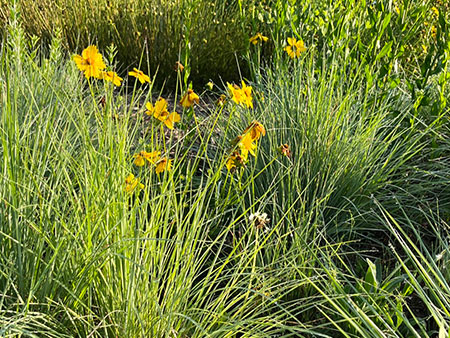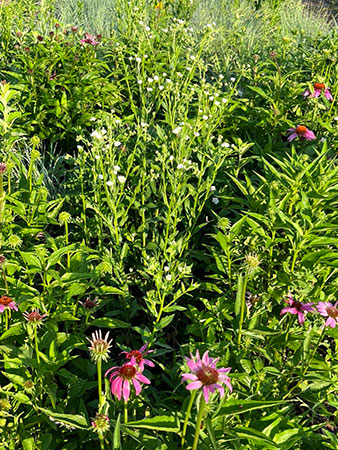Backyard Garden: Native Garden

The Native Garden area provides homeowners (including those with HOA rules) with an opportunity to see how natives, cultivars of natives (nativars), and drought tolerant annual plants can be used in a low-maintenance landscape plan. The Native Garden area was created (in part) to encourage homeowners to trade turf for drought tolerant plants.
Points of Interest:
- The area includes multiple stand alone beds which were first planted in 2014-2015.
 Plants in the native area include:
Plants in the native area include:
- Purple coneflower (Echinacea purpurea)
- Poppy mallow (Callirhoe involucrata)
- Blazing star (Liatris spicata), also known as gayfeather
- False indigo (Baptisia australis), aromatic aster, (Symphyotrichum oblongifolium),
- Eastern Redbud (Cercis canadensis).
- The Native Garden area uses two types of planting styles; Prairie & Drift Style.
- The Prairie style reflects the traditional prairie look and uses multiple varieties of plants scattered randomly.
- The Drift style uses a limited number of plant varieties planted in groups or “drifts” that reflect more formal landscaping. This planting approach is often easier to maintain for people who are not experts on native plants.
- In 2022, a very dry year, the only plants watered were the three new shrubs which were added thereby demonstrating that a well planned native garden can tolerate times of drought.
Tips:
- Determine your timeline for transitioning to more Native plants
Inventory what Native and exotic (non-native) plants you have - Replace plants that you find don’t work in your current landscape with Native plants
- Set a goal of for the number of Native plants you want to have in your landscape
- Consider the special uses for Natives you wish to plant such as food sources, seasonal color, textures, medicinal, fragrance, etc
- Know the growth habit of the Native plants you select
- Strive for a mixture of plants (trees, shrubs, grasses, flowers, etc)
- Consider the light requirements of the Natives you select and pair them with other Natives of like requirements
- Add drought-tolerant annuals and bulbs as desired for more continuous color
Garden Address
35230 W 135th St
Olathe, KS 66061
Master Gardeners are available to answer questions and provide tours while they work the gardens Wednesday mornings, March to October. To schedule a visit on another day (M-F), please contact us at bygjocoemg@gmail.com
Have questions? The Garden Hotline is staffed by trained EMG volunteers and Extension staff who will assist you with questions.
Phone: (913) 715-7050
Email: garden.help@jocogov.org